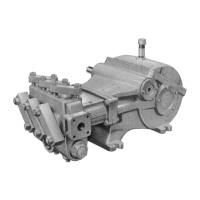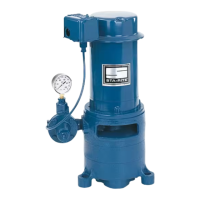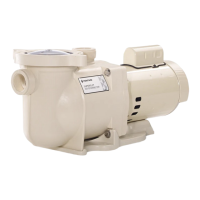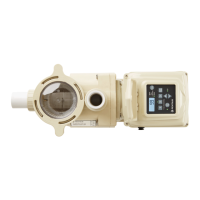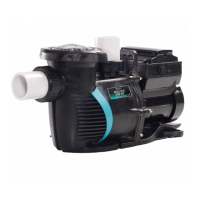54
3. The motor and bracket assembly can now
be removed from the pump case by pulling
horizontally away from the case.
4. Remove the O-ring from the case inner neck and
then remove the cap screws that hold the diffuser
in place and lift off diffuser.
5. All three phase and 5 hp units – hold impeller or
motor shaft and remove hex nut located in the
impeller eye and unscrew the impeller.
6. The mechanical shaft seal components can
now be removed from the motor shaft and bracket
respectively.
7. Remove the cap screws that secure the bracket to
the motor and remove the bracket. The deflector
can now be removed from the motor shaft.
8. Remove the O-ring from the bracket neck.
A new shaft seal should always be used when
rebuilding a pump. All pump parts should be cleaned
thoroughly before being reassembled.
PUMP ASSEMBLY INSTRUCTIONS
1. Slip deflector onto the motor shaft extension and
with motor in vertical position, place bracket onto
motor face register and secure bracket to motor
with cap screws. Ensure that the motor, when in
operating position, has the shell air slots in the
down position.
2. Place stationary shaft seal component over pump
shaft extension and seat into provided bracket
bore. Follow with the rotating seal component onto
the motor shaft.
3. Place the impeller onto the pump shaft
extension until the impeller back hub rests on
the shaft shoulder. Screw in impeller capscrew.
4. Place the diffuser over the impeller with the diffuser
volute face against the bracket. Equally space
three .005 shims between the impeller hub and the
diffuser I.D. Assemble the cap screws and tighten
alternately, so the diffuser is not pulled to one side.
Remove the three shims and as the impeller is
revolved it should turn freely.
5. Place gasket over the bracket register diameter
and position against the provided face, then place
gasket over the inner neck in the pump case and
place against the provided face. The assembly can
now be reassembled to the pump case.
6. Using cap screws, secure bracket to case. The
motor wiring can now be connected and the unit
reprimed. Install the previously removed fuses from
the entrance switch and close the switch; the unit
is now in operation again.
TROUBLESHOOTING
No water delivered
1. Pump not p
roperly primed.
2. Discharge system head too great; in this case, a
pressure gauge at the pump discharge will show
shut off pressure.
3. Suction lift too great; check with vacuum
gauge. Check or foot valve, if used, may be
completely plugged or suction piping may
be completely plugged.
4. Air leak in suction piping.
5. Wrong motor rotation.
6. Shaft seal leaking under priming conditions.
7. Motor not up to speed; check for incorrect voltage.
8. Plugged impell
er.
Not enough water or pressure
1. Air leak in suction piping.
2. Motor not up to speed; check for incorrect voltage
or low voltage.
3. Discharge system head too great.
4. Impeller, suction pipe, check or foot valve
partially plugged.
5. Wrong motor rotation.
6. Suction lift too great.
7. Insufficient submergence of suction pipe. Suction
pipe inlet should be at least 3 feet below the liquid
surface at all times.
8. Pump too small for installation involved.
9. Suction piping too small causing excessive total
suction lift.
10. Air or gas entrained in liquid.
11. Worn impeller or diffuser.
Pump loses prime after starting
1. Air leak in suction piping.
2. Total suction lift too great.
3. Insufficient submergence of suction pipe; check
pumping water level.
Motor overheats
1. Check rotating element to ensure that it turns freely.
2. Low voltage at the motor. Check electrical
connections to ensure tight contact.
3. Poor ventilation.
Pump vibrates or is noisy
1. Insufficient pump foundation.
2. Excessive total suction lift.
3. Bent shaft or worn motor bearings.
4. Impeller partially clogged.
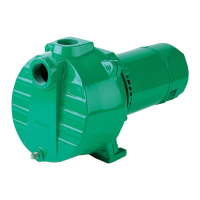
